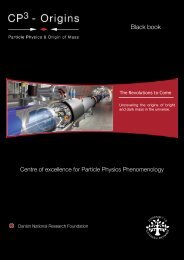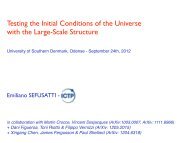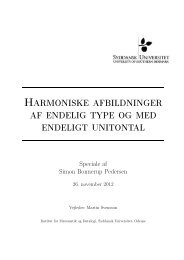PhD thesis - CP3-Origins
PhD thesis - CP3-Origins
PhD thesis - CP3-Origins
Create successful ePaper yourself
Turn your PDF publications into a flip-book with our unique Google optimized e-Paper software.
QCD and Chiral Symmetry Breaking 33The preferred vacuum is the one which minimizes Tr ( ) 2.X Z(A) The second condition inequation (3.49) can now be written as:∂ 2m 2 xy = 1 Tr (X Z (A)) 2 × M 2 ≥ 0, (3.61)2 ∂α x ∂α ywhereM 2 = 1 ∫fπ2d 4 x∆ µν 〈0|J µT J νT − J µX J νX |0〉 . (3.62)The α dependence is, as stated earlier, only in the trace. In next section we will see howone can estimate the factor M 2 .3.6. Weinberg Sum RulesProperties of the underlying theory can be linked to the effective theory via Weinbergsum rules (WSRs) [32]. To derive the sum rules let us consider the time ordered productof two currentsiΠ abµν(q) ≡∫d 4 xe −iqx [ 〈 0|J a µ,V (x)J b ν,V (0)|0 〉 − 〈 0|J a µ,A(x)J b ν,A(0)|0 〉 ] (3.63)where a, b = 1, . . . , N 2 − 1 and the current read asJ a µ,V = ¯QT a γ µ Q, J a µ,A = ¯QT a γ µ γ 5 Q. (3.64)In the chiral limitΠ abµν(q) = (q µ q ν − g µν q 2 )δ ab Π(q 2 ), (3.65)where the function Π(q 2 ) obeys the unsubtracted dispersion relationΠ(Q 2 ) = 1 π∫ ∞0ds ImΠ(s)s + Q 2 . (3.66)








